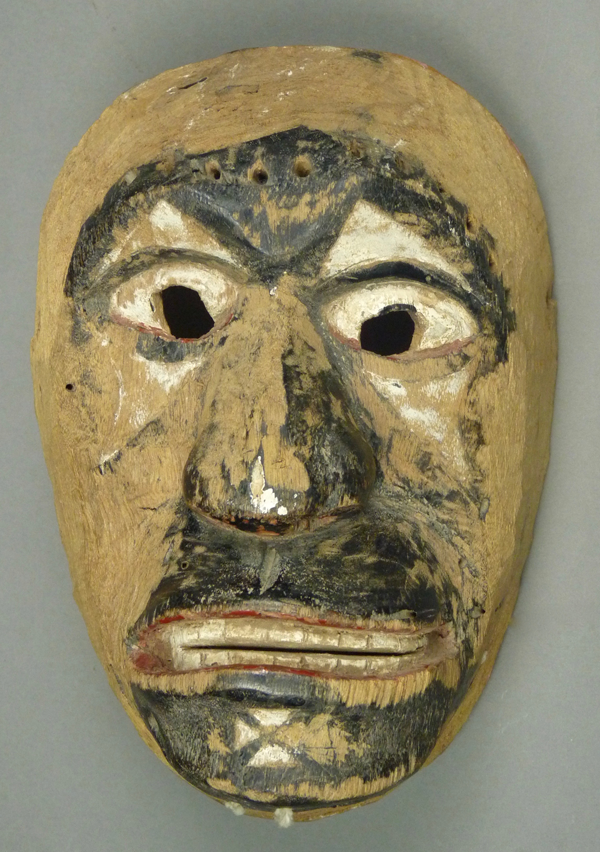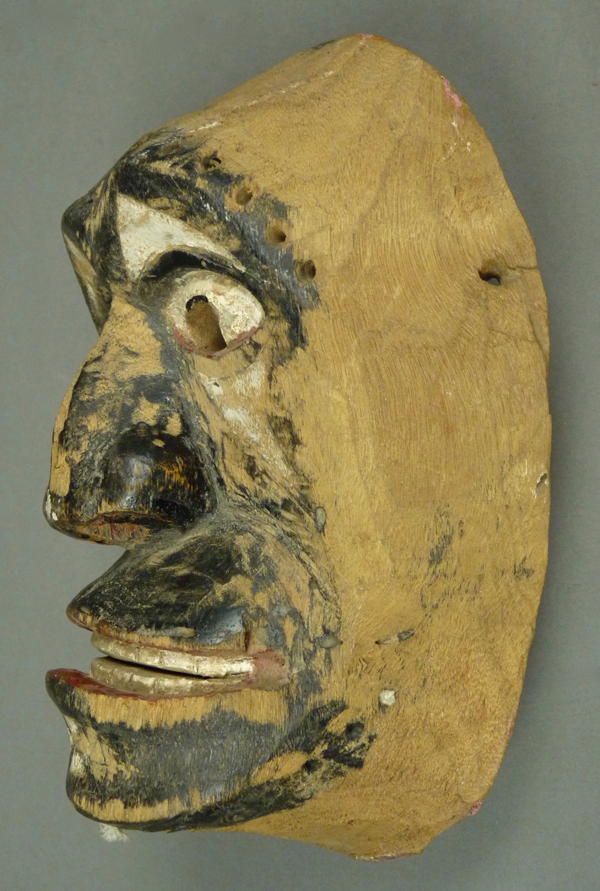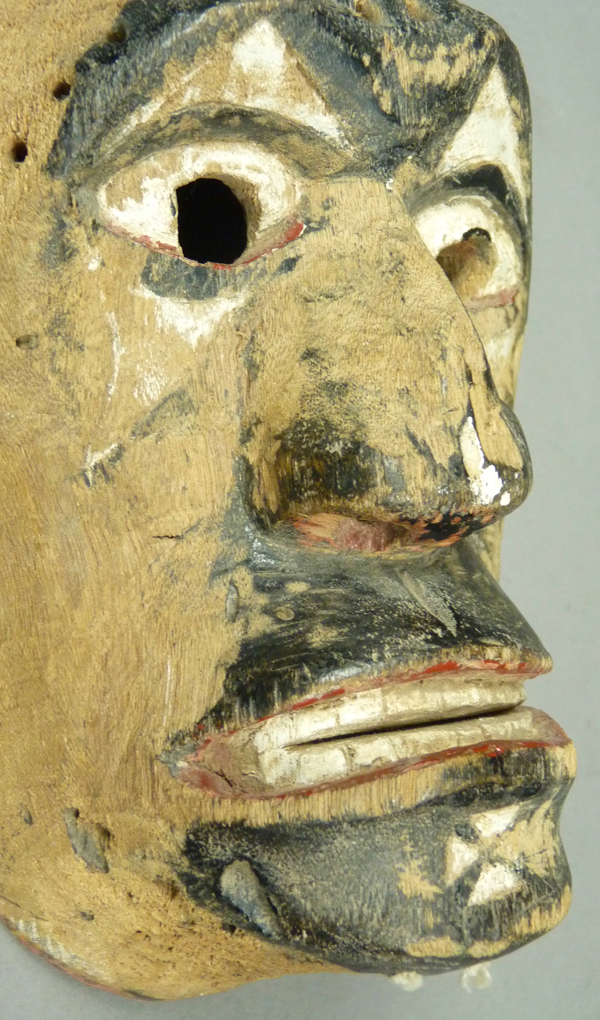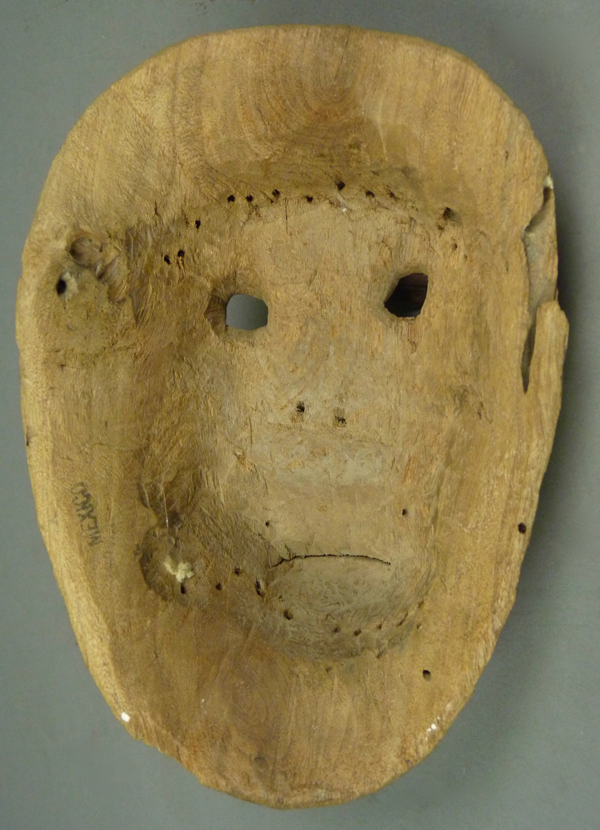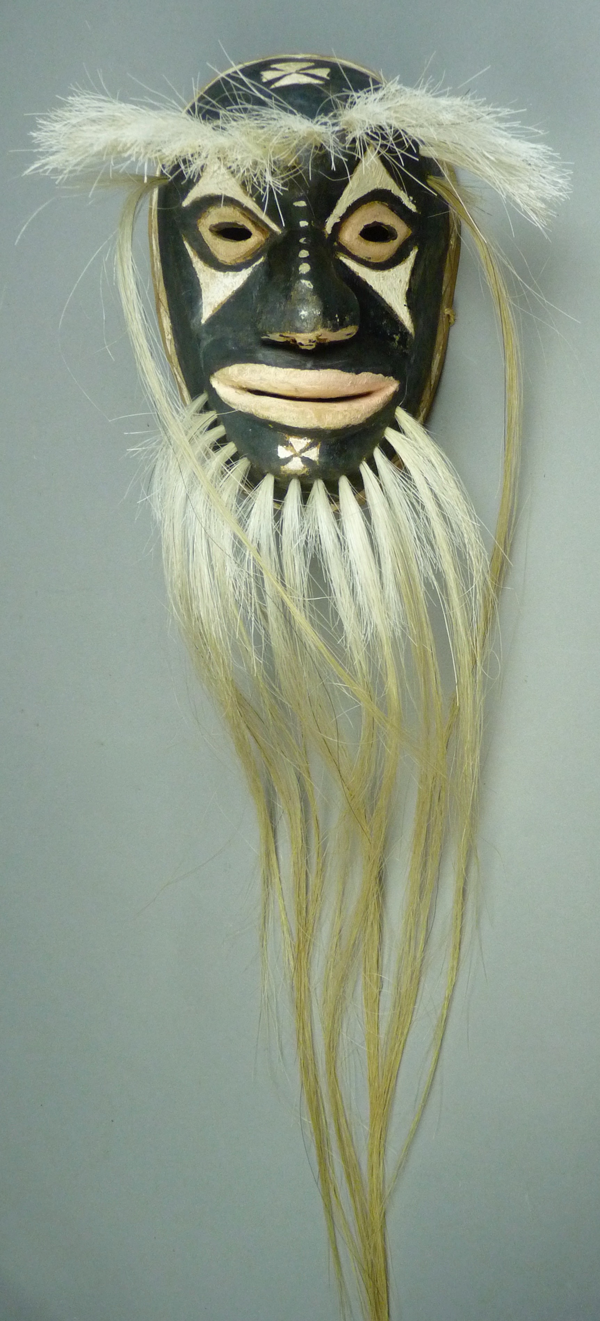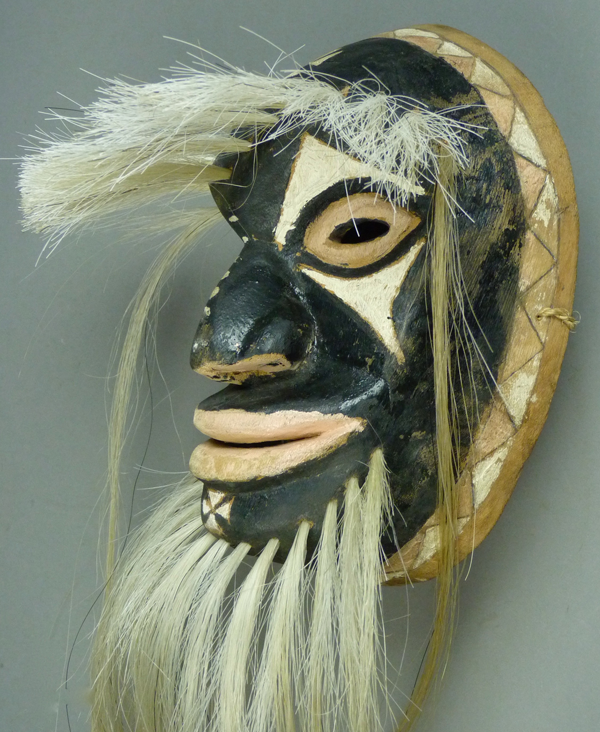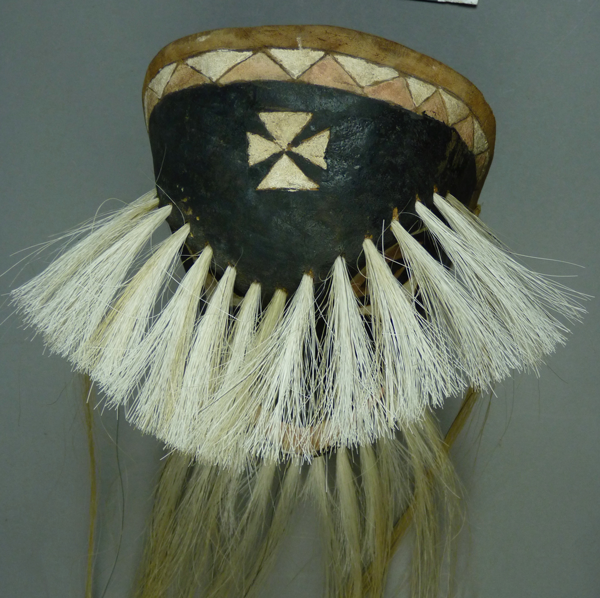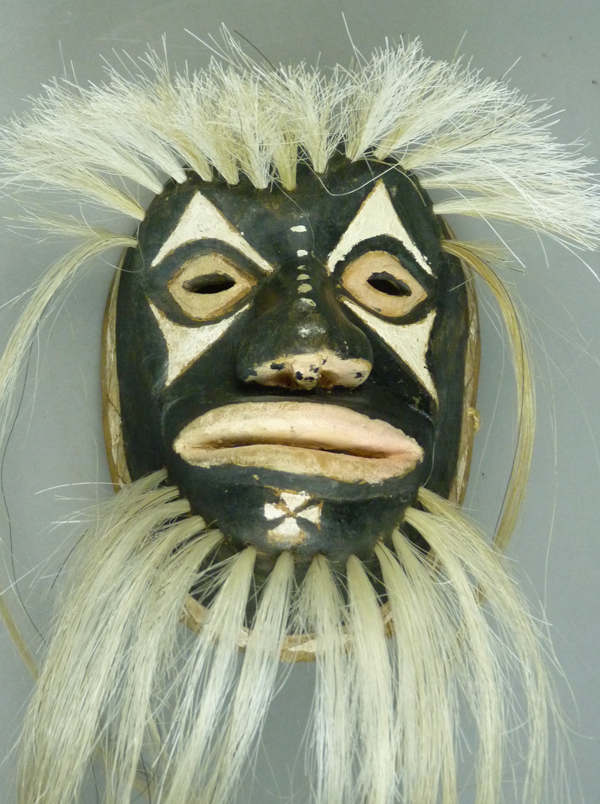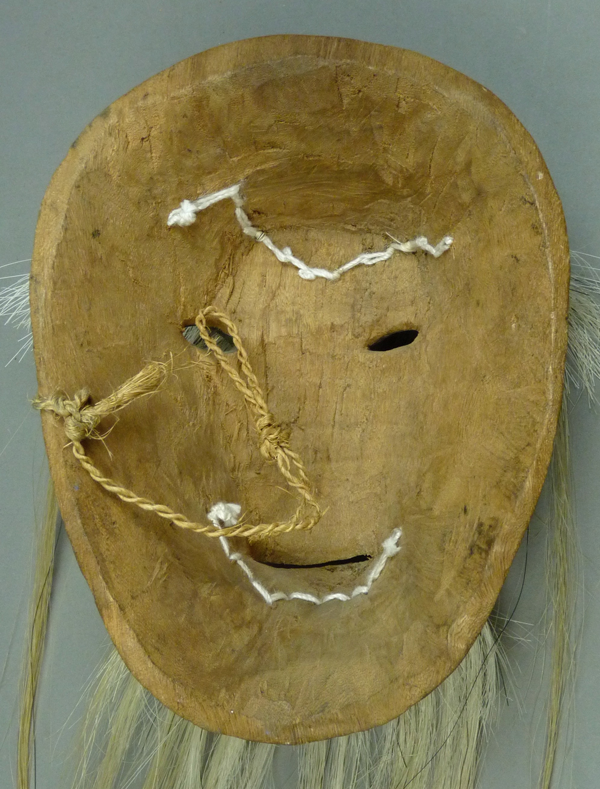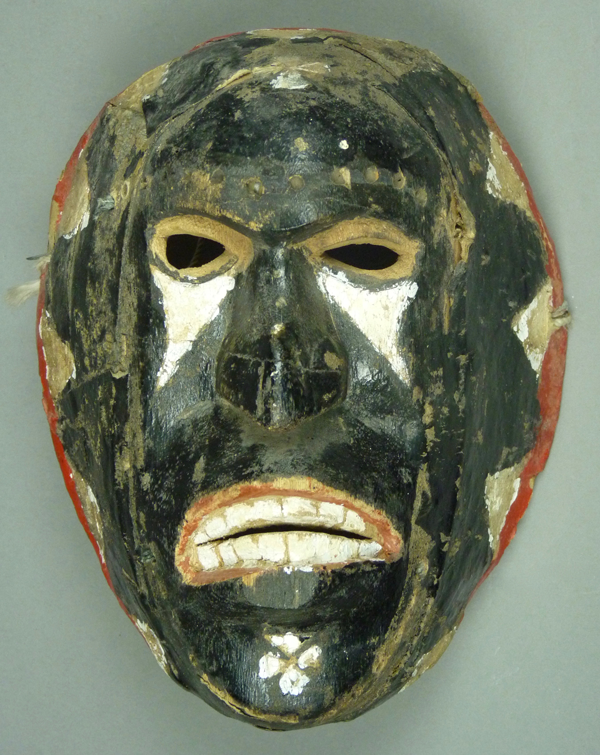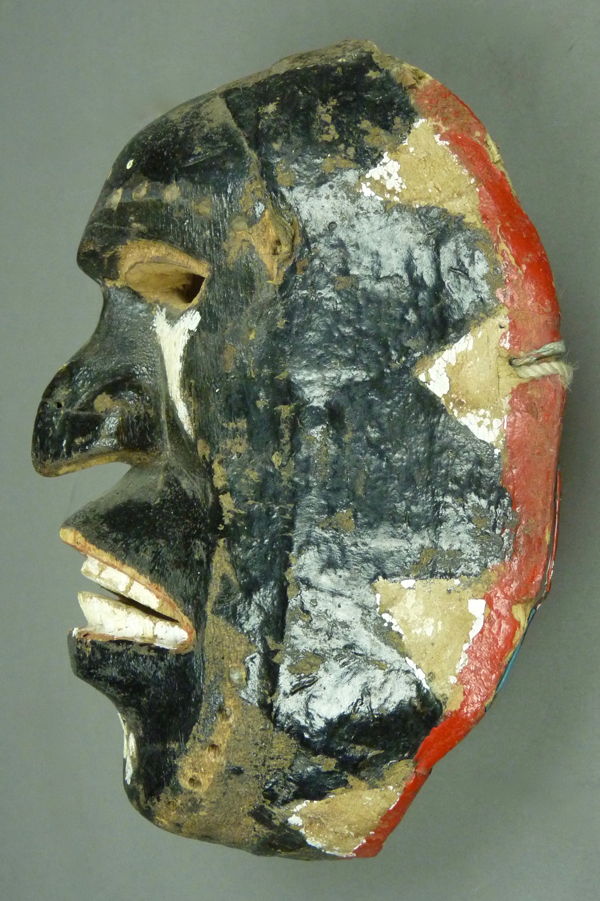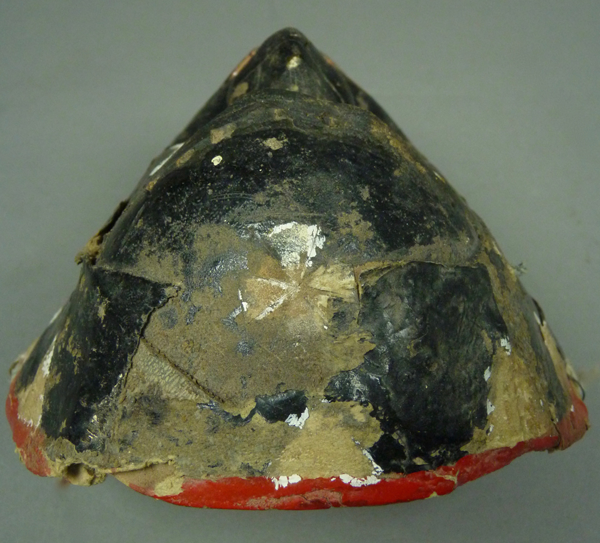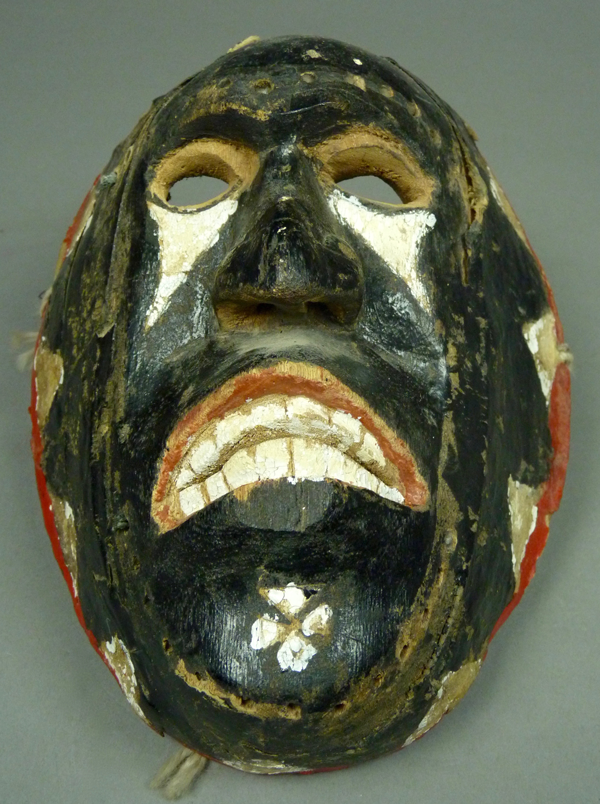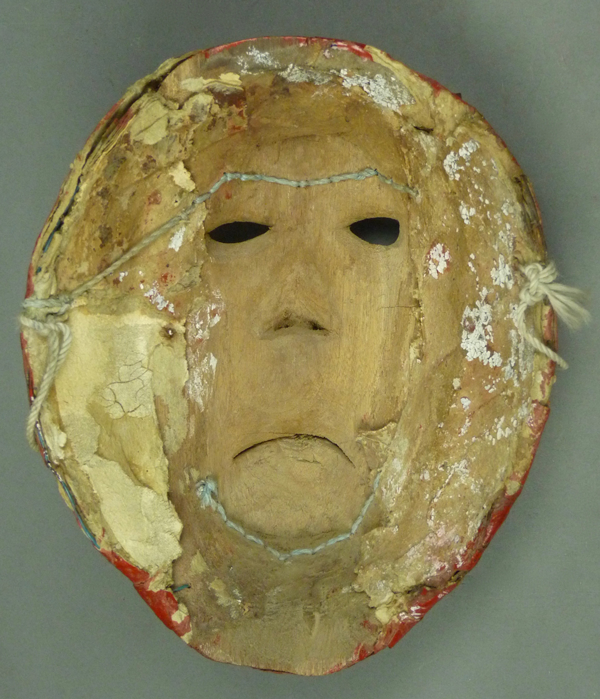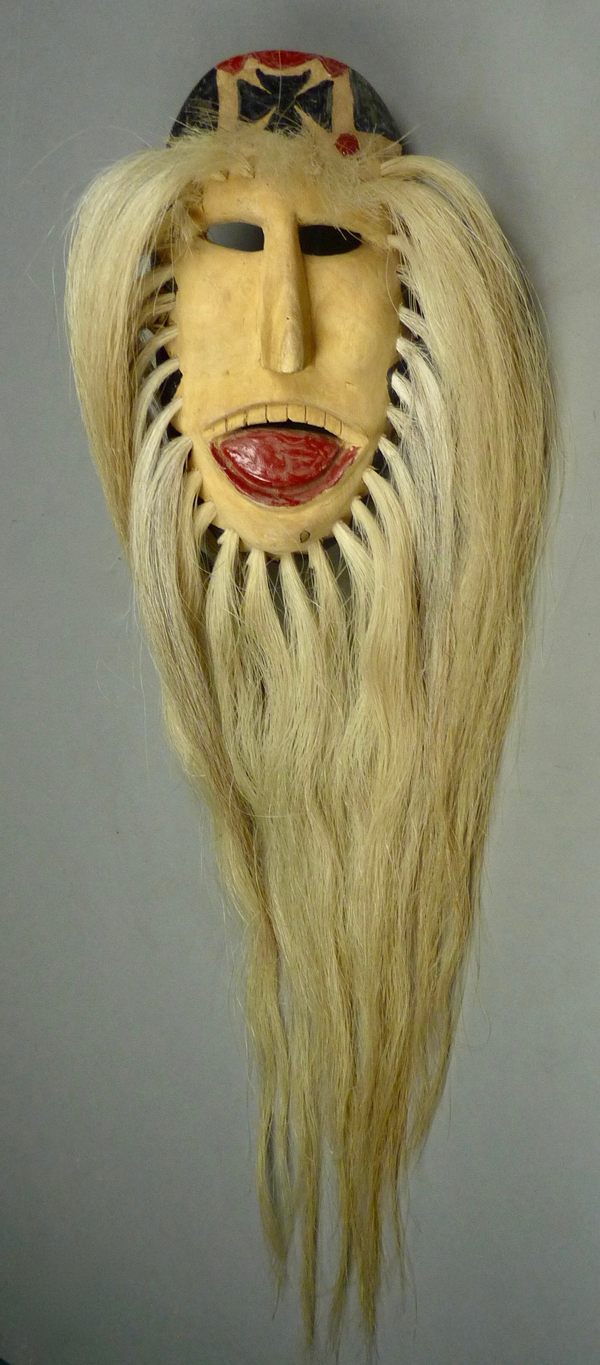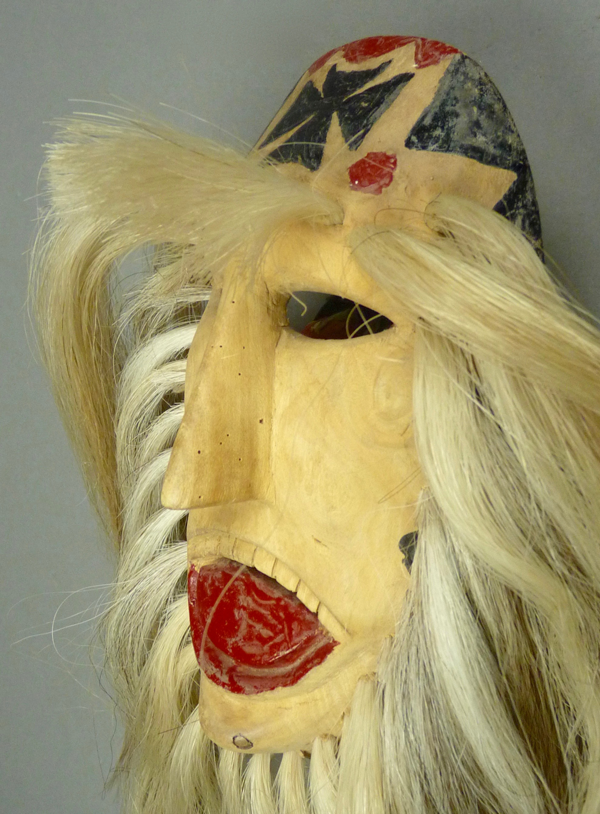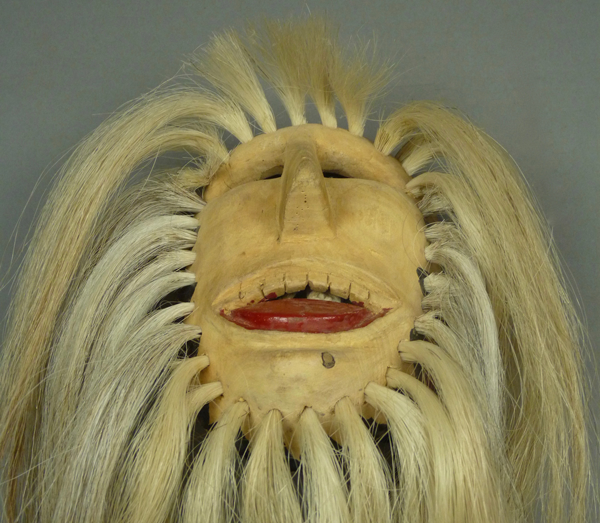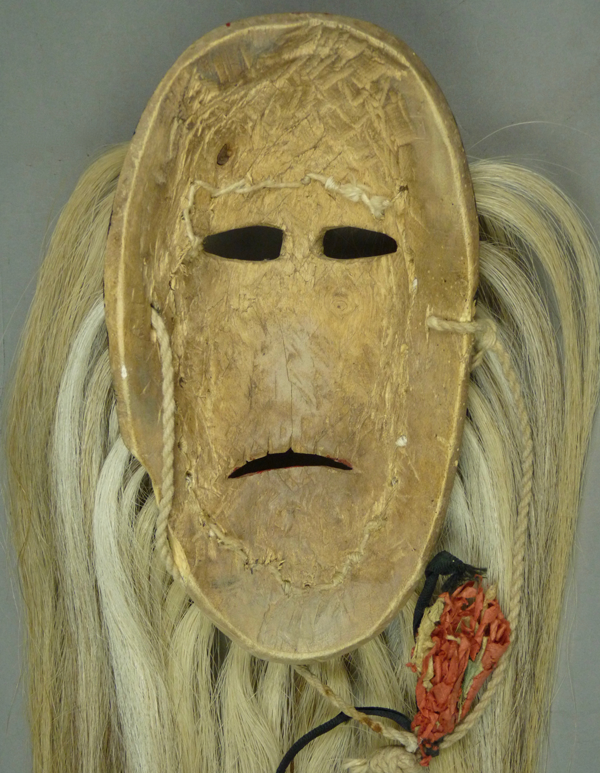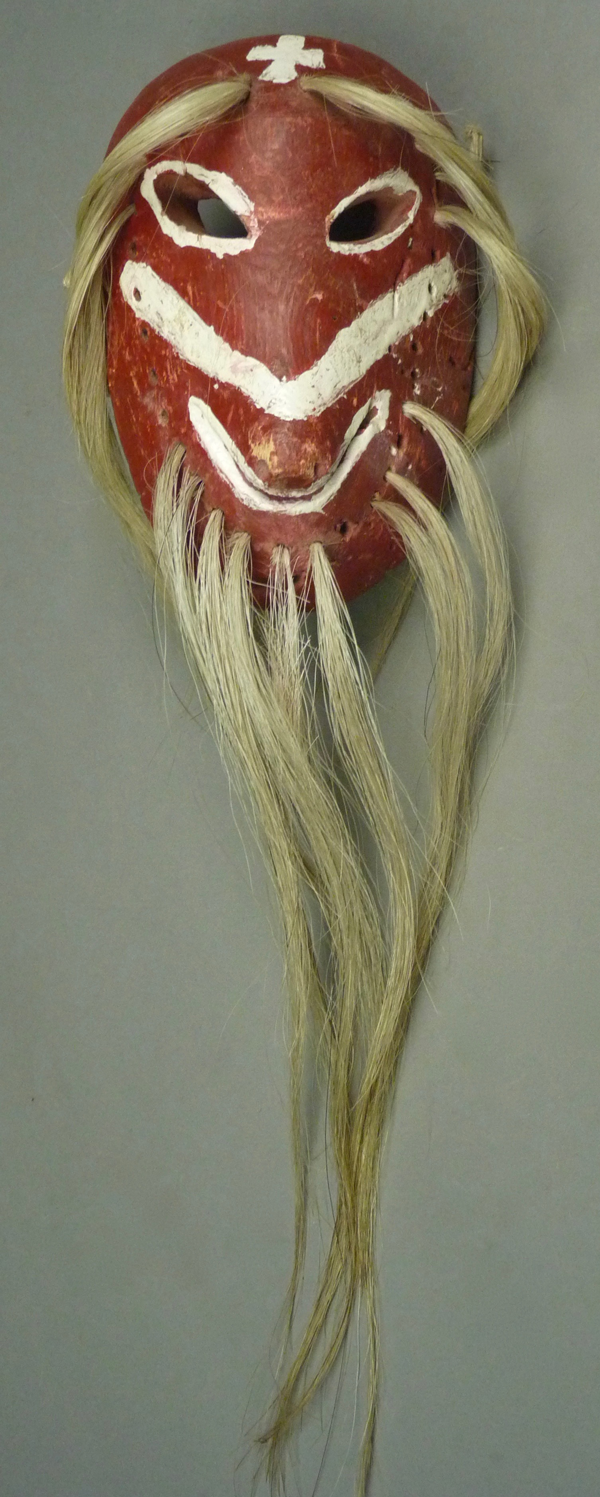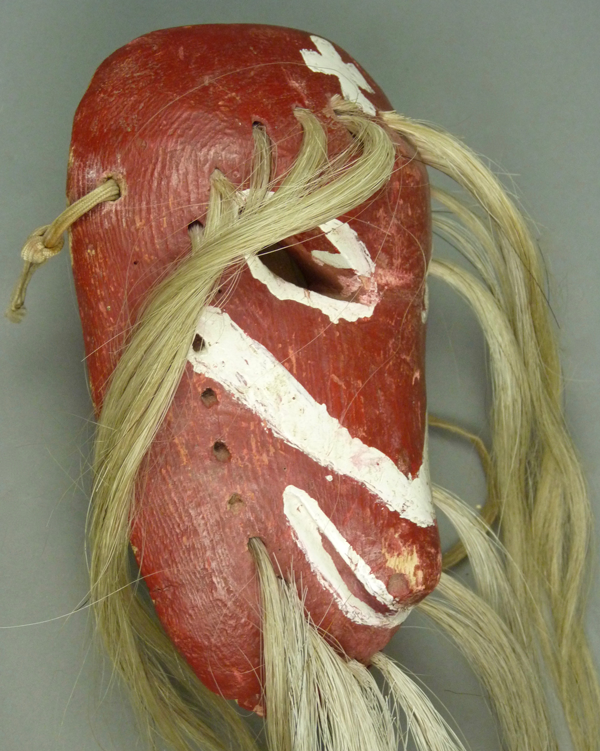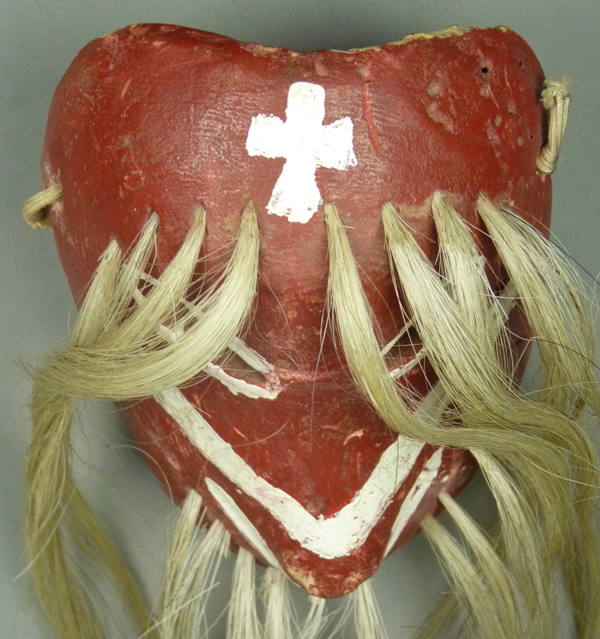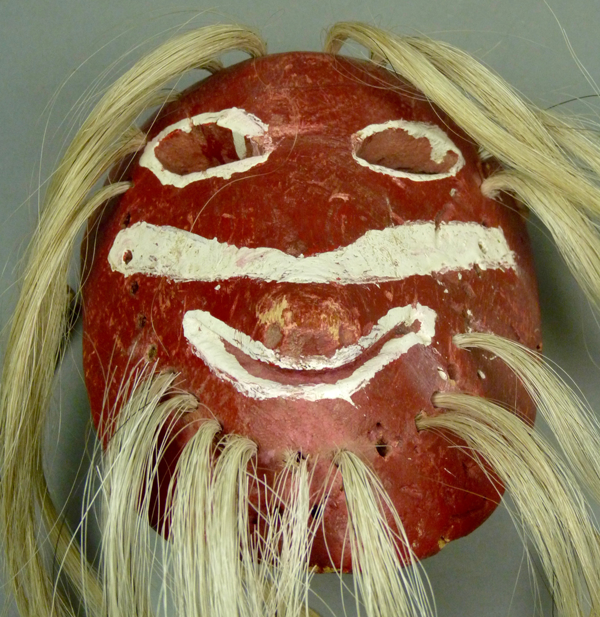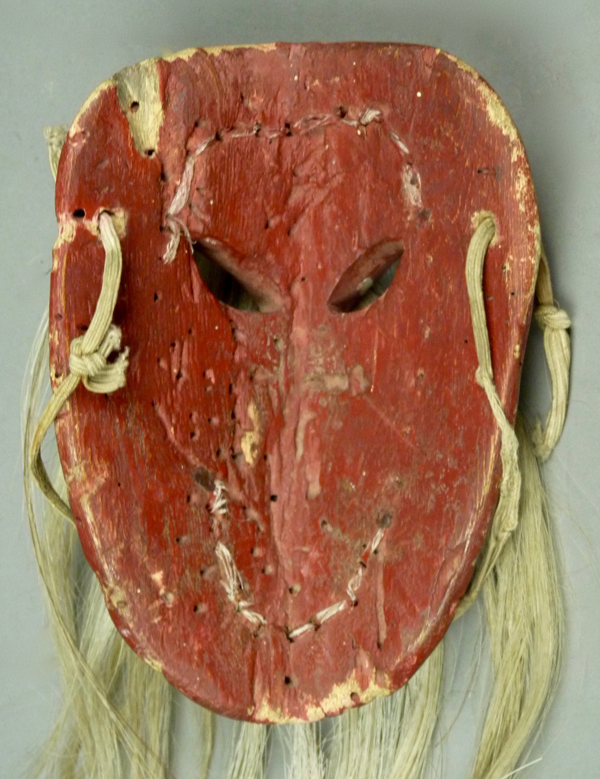A cluster of four Pascola masks showed up recently on EBay™, for sale by Gallery West of Tucson. Two Yaqui masks bear telltale design details of my favorite Yoeme carver, Manuel Centella Escalante. He lived and worked in Potam, Sonora, but frequently traveled to the Yaqui villages in the Tucson area to participate in fiestas. The condition of the Yaqui masks might not appeal to all collectors. The other two, charming Mayo Pascola masks from the Mexican state of Sinaloa, are certainly in far better condition.
Here is the first of the pair I am attributing to Manuel Centella Escalante. Someone had scraped the paint on the face, probably in preparation for repainting, but then a Yaqui picker, Rodrigo Rodriguez, who was also a well-known mask carver, had purchased it in 1984, before it could be repainted. It was said to be the work of Antonio Faroi, a carver who is unknown to me. Roberto had bought it for Barney T. Burns. Barney sold it to a Tucson collector, who showed me the mask in 2004. Despite the scraping, there were enough of the original painted designs left to indicate that Manuel Centella had surely been the maker. Many years after that moment of recognition, when the mask had passed through other hands, I was able to purchase in on EBay, in May 2018. I estimate that this mask was actually carved in the 1960s or 70s, roughly 50 or 60 years ago. I should note that my ability to spot this maker’s work had been vastly sharpened by the kind teaching of my friend, Tom Kolaz of Tucson, who is another great fan of Manuel Centella’s work.
Typical Manuel Centella features are visible, including the white triangles over the eyes, the large and broad nose (with white painted designs on a vertical line down the center), the graceful artistic white triangles under the eyes, the small carved teeth, and the chin cross of four small triangles with inscribed outlines. There would have been a similar but larger cross on the forehead.
This side view gives a much better picture of the nose. Also you may notice the attractive expression of the mouth. Barely visible are small remnants of the original rim design—a hot pink line around the edge of the rim, and white triangles with their bases inside that pink line.
The point of this close-up view is to illustrate the graceful inscribed and painted triangle under the right eye.
This mask is 7¾ inches tall, 5¼ inches wide, and 3 inches deep.
The back shows significant staining from use. The right edge has been damaged.
For comparison, I will follow this mask with photos of an intact example that has similar features, from my post of December 19, 2016. For the curious, here is the link:
https://mexicandancemasks.com/?p=7596#more-7596
And here is that similar mask from the earlier post, which was carved by Manuel Centella, danced by Lino Suarez, the lead Pascola dancer at Old Pascua in Tucson, rescued from Lino’s abandoned house after his death through the efforts of Tom Kolaz and others, and re-haired by a Tucson Yoeme mask maker, David Valenzuela.
Note the triangles above and below the eyes, the forehead and chin crosses of four triangles, the oversized nose with white dots painted down the center line, and the characteristic rim design of a plain yellow line along the rim and double triangles within that lane.
Missing on this example are the small carved teeth.
The crosses are composed of four inscribed triangles with their points together.
This mask is 7¾ inches tall, 5½ inches wide, and 3½ inches deep, very nearly the same size as the one above and the other that follows.
Signs of wear and weathering are evident. This was one of a group of masks that Lino Suarez used during his years of dancing.
The second EBay mask was purchased by William Smith, the owner of the Barrio Viejo Gallery of Tucson, in 1981. He bought it from Francisco Matus of Barrio Libre in South Tucson, who indicated that the mask had been danced by members of his family. This mask had not only been repainted, but also the sides had been patched or extended with paper or cardboard on the front and back. My Tucson collector friend purchased the mask from Bill Smith, probably also in 1981 or soon after that. When I was shown this mask in 2004, I immediately identified it as another typical example of Manuel Centella’s work. And again, when I recently had the opportunity to buy this mask, after it too had passed through many other hands, I jumped at the chance.
This mask has the same forehead and chin crosses that would have been original to the first mask. However, sloppy repainting obscures their design. In the photo just above, you may be able to see the inscribed outline of the triangles that form the chin cross. This mask did not have Centella’s typical triangles over the eyes, but the graceful ones under the eyes can still be seen, along with his typical small carved teeth. White dots down the ridge of the nose were also common on Centella’s masks; these dots have nearly worn away after extensive use.
The dramatic shaping of the nose and mouth is more apparent in this side view. Paper or cardboard was applied along the sides of the mask, which were then clumsily repainted. As I noted on the first mask, Centella did have a favorite rim design, which consisted of a thin band of color around the edge that enclosed a row of additional decorative elements. These were often triangles, but sometimes half circles or other designs. That sort of rim design has been reapplied, but Centella never made such wide and uneven bands along the back edge.
This top view is meant to demonstrate the inscribed triangles that form the forehead cross.
Likewise the chin view reveals the same elements on the chin cross.
This mask is 7½ inches tall, 6 inches wide, and 3 inches deep.
Staining from long use is particularly apparent on the back of the chin.
The last two masks in this post are Mayo Pascola masks from the Mexican state of Sinaloa. There is a human faced mask and another with the face of a goat.
Here is the Sinaloa Mayo mask with a human face. It was collected by Roberto Ruiz for Barney T. Burns on May 5, 1983. It was allegedly sold by the carver, Beto Guicho. about whom I know nothing. I bought it on EBay on May 14, 2018. It is a strange but interesting observation that the Mayo Indians in Sonora, who live near the Rio Mayo, use many human faced Pascola masks and very few Goat Pascola masks, while those in Sinaloa, who live near the Rio Fuerte, seem to favor goat faced masks over those with human faces. This danced and well-carved human faced mask from Sinaloa is a nice example of a less common mask.
Note that some Sinaloa Mayo masks, such as this one, have a ring of hair tufts around the face, instead of brows (or a unibrow) and beard. Sinaloa Pascola masks tend to have very long brow and beard hair, and they prefer to wear it draped over the vision slits. I have pulled the hair back to reveal the face.
This mask portrays an extended tongue, a feature that has been popular for both Yaqui and Mayo Pascola masks.
Like Yaqui Pascola masks, Mayo Pascola masks frequently have a cross on the forehead and a rim design, but they seldom have a second cross on the chin. The hair across the forehead has been clipped on this mask, although more generally these hair bundles are as long as the rest on Sinaloa masks.
This mask is 8 inches tall, 4½ inches wide, and 2½ inches deep.
There is extensive staining from use, the mask has an original strap, and the paper flower worn in the Pascola’s hair during a fiesta has been preserved with the mask. There is a broken spot on the left lower edge of the rim.
The last mask in today’s post is a Goat Pascola mask from Sinaloa. This too was collected by Roberto Ruiz for Barney T. Burns in February 1983, after 6 years of use. It was carved from Chilicote (Coral-bean) wood, which is light in weight and very easily carved. Like the last, this mask too was originally fitted with a ring of hair tufts, the circle of holes for hair tufts remains, but subsequent hair loss has left it with the appearance of separate brows and a beard.
This mask lacks a rim design.
The paint on the face of this mask is obviously worn. The Maltese Cross on the forehead was crudely painted.
The painted decoration on the face of a goat Pascola mask tends to be idiosyncratic, at the whim of the artist. I find this white V across the face to be charming and effective.
This mask is 7 inches tall, 5 inches wide, and 2¼ inches deep. A mask this size could have been worn by an adult or a child.
There is obvious wear of the paint on the back of this mask, and the original strap is also soiled from use.
Next week we will look at paper masks from Mexico.
Bryan Stevens

